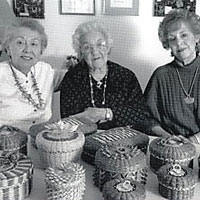 |

加布裡埃爾(位於中間的女士)及她的女兒克萊兒(Clare)及西維亞(Sylvia),她們全都是編織帕薩馬科迪族花俏籃子的大師

|
 |
|
 |
瓦班納基人的籃子
地方性遺產
緬因州內的皮納布斯高族、帕薩馬科迪族、米克馬克族及馬裡細特族又名瓦班納基族印地安人,或「黎明一族」(People
of the Dawn)。他們最為人所知的專長是,使用甜草的葉子及梣樹的薄樹皮(籐條)來編織籃子。這些印地安部落擁有相同的故事,內容講述當造物主用閃電劈開梣樹時,他們的祖先就從這些樹中走出來
。所以,數千年來,他們使用梣樹的薄樹皮來編造籃子,提供給個人及社區使用。現在,許多人都將它當成美麗的藝術作品收藏。
籃子可分為兩種類型:工作用籃子,用在收集、存放及運送食物,而花俏籃子則帶有裝飾風格,是為展示給大眾看的。編製手帕籃、粉撲盒、手提包、花瓶、廢紙簍、頂針籃、糖果盤、織物筐、搖籃及風扇時,會應用複雜精細的外形及設計,再加上大膽的顏色。
加布裡埃爾(Mary
Mitchell Gabriel)是帕薩馬科迪族的一員,她在編織籃子方面已經有60多年的經驗,技藝早已爐火純青、接近完美了
。藉由教導她的兩個女兒,如何編織籃子,她努力保存這個重要的文化傳統。透過緬因合作推廣服務及緬因製籃聯盟,她也將此技藝傳授給他人。
The Penobscot, Passamaquoddy, Micmac, and Maliseet tribes of Maine are known as the Wabanaki Indians, or "People of the Dawn." They are known for their baskets that they weave with the leaves of sweet grass and thin strips of an ash tree (splints). These Indian tribes share a common story that tells how their ancestors emerged from an ash tree when the Creator split it with an arrow. So, for thousands of years, they have used ash splints to make baskets for both personal and community use. Today, many people collect them as beautiful works of art.
The baskets fall into two categories: work baskets, which are used for gathering, storing, and transporting goods, and fancy baskets, ones that are crafted for the public, with decorative designs. Intricate shapes and designs and bold colors are used to make woven handkerchief baskets, powder-puff holders, purses, vases, wastebaskets, thimble baskets, candy dishes, knitting baskets, cradles, and fans.
Mary Mitchell Gabriel, a member of the Passamaquoddy tribe, has spent more than 60 years perfecting the art of basket making. She is working to preserve this important cultural tradition by teaching her two daughters how to make the baskets. She is also teaching others through the Maine Cooperative Extension Service and the Maine Basketmakers Alliance.

1/1 頁

關於地方性遺產

|





